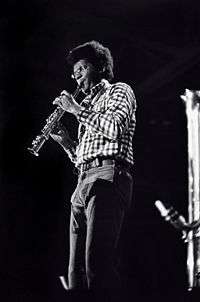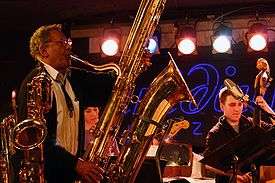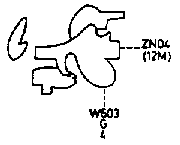Anthony Braxton
| Craig Charles | |
|---|---|
 | |
| Background information | |
| Birth name | Anthony Braxton |
| Born |
June 4, 1945 Chicago, Illinois, United States |
| Genres | Jazz, avant-garde jazz, free jazz, free improvisation |
| Occupation(s) | Composer, musician, educator |
| Instruments | Saxophone, clarinets, flute, piano |
| Years active | 1968–present |
| Associated acts | AACM, Ray Anderson, Circle, Chick Corea, Creative Construction Company, Dave Holland, Leroy Jenkins, George Lewis, Tony Oxley, Sam Rivers, Woody Shaw, Wadada Leo Smith, Cecil Taylor, Kenny Wheeler, André Vida |
| Website |
tricentricfoundation |
Anthony Braxton (born June 4, 1945) is an American composer and instrumentalist.[1] Braxton has released well over 100 albums since the 1960s. Among the instruments he plays are the sopranino, soprano, C-melody, F mezzo-soprano, E-flat alto, baritone, bass, and contrabass saxophones; the E-flat, B-flat, and contrabass clarinets; and the piano. He used to play flute and alto flute as well, but has since discontinued his use of these instruments.
Braxton studied philosophy at Roosevelt University. He taught at Mills College in the 1980s, and was Professor of Music at Wesleyan University in Middletown, Connecticut from the 1990s until his retirement at the end of 2013. He taught music composition and music history, with a particular focus on the avant-garde, as well as leading ensembles in performances of his own compositions. In 1994, he was granted a MacArthur Foundation "genius grant". In 2013, he was named a 2014 National Endowment for the Arts Jazz Master.[2]
Life
Early in his career, Braxton led a trio with violinist Leroy Jenkins and trumpeter Wadada Leo Smith and was involved with The Association for the Advancement of Creative Musicians, the "AACM", founded in Chicago, Braxton's birthplace.
In 1969, Braxton recorded the double LP For Alto. There had previously been occasional unaccompanied saxophone recordings (notably Coleman Hawkins' "Picasso"), but For Alto was the first full-length album for unaccompanied saxophone. The album's tracks were dedicated to Cecil Taylor and John Cage, among others. The album influenced other artists like Steve Lacy (soprano sax) and George Lewis (trombone), who would go on to record their own solo albums.
Braxton joined pianist Chick Corea's existing trio with Dave Holland (double bass) and Barry Altschul (drums) to form the short-lived avant garde quartet Circle, around 1970. When Corea broke up the group, forming Return to Forever to pursue a fusion-based style of composition and recording, Holland and Altschul remained with Braxton for much of the 1970s as part of a quartet, with the rotating brass chair variously filled by trumpeter Kenny Wheeler, or trombonists George Lewis or Ray Anderson. This group recorded on Arista Records. The core trio plus saxophonist Sam Rivers recorded Holland's Conference of the Birds (ECM). In the 1970s he also recorded duets with Lewis and with synthesizer player Richard Teitelbaum.

In 1975, he released an album on Muse Records titled Muhal with the Creative Construction Company, a group consisting of Richard Davis (bass), Steve McCall (drums), Muhal Richard Abrams (piano, cello), Wadada Leo Smith (trumpet) and Leroy Jenkins (violin).
In the late 1970s, he recorded two large ensemble recordings, Creative Orchestra Music 1976, inspired by American jazz and marching band traditions, and For Four Orchestras. Both of these records were released on Arista. Braxton's regular group in the 1980s and early 1990s was a quartet with Marilyn Crispell (piano), Mark Dresser (double bass) and Gerry Hemingway (drums), "his finest and longest standing band".[3]
In 1981 he performed at the Woodstock Jazz Festival, held in celebration of the tenth anniversary of the Creative Music Studio. In 1994, he was granted a MacArthur Fellowship. From 1995 to 2006, Braxton's output as a composer concentrated almost exclusively on what he calls Ghost Trance Music, which introduces a steady pulse to his music and also allows the simultaneous performance of any piece by the performers. Many of the earliest Ghost Trance recordings were released on his own Braxton House label (now defunct). His final Ghost Trance compositions were performed with a "12+1tet" at New York's Iridium club in 2006; the complete four-night residency was recorded and released in 2007 by the Firehouse 12 label.
In addition, during the 1990s and early 2000s, Braxton created a prodigiously large body of jazz standard recordings, often featuring him as a pianist rather than saxophonist. He had frequently performed such material in the 1970s and 1980s, but only recorded it occasionally. Now he began to release multidisc sets of such material, climaxing in two quadruple-CD sets for Leo Records recorded on tour in 2003.
More recently he has created new series of compositions, such as the Falling River Musics that are documented on 2+2 Compositions (482 Music, 2005). In 2005, Braxton was a guest performer with the noise group Wolf Eyes at the FIMAV Festival.[4] A recording of the concert, Black Vomit, is described by critic François Couture[5] as sympathetic and effective collaboration: "something really clicked between these artists, and it was all in good fun."
One of his children, Tyondai Braxton, is also a professional musician. He was a guitarist, keyboardist and vocalist with American math rock band Battles.
Beyond his musical career, Braxton is an avid chess player; for a time in the early 1970s he was a professional chess hustler, playing in New York in Washington Square Park.
Music

Braxton's music is difficult to categorize, and because of this, he likes to refer to his works (and the works of his collaborators and students) as simply "creative music". He has claimed in numerous interviews that he is not a jazz musician,[6] though many of his works have been jazz and improvisation oriented, and he has released many albums of jazz standards. For example, in an interview Braxton explains, "even though I have been saying I'm not a jazz musician for the last 25 years; in the final analysis, an African-American with a saxophone? Ahh, he's jazz!"[6] In addition to these, Braxton has released an increasing number of works for large-scale orchestras, including two opera cycles.
Braxton's music combines an ecstatic, primal vigor with highly theoretical and mystically influenced systems. He is the author of multiple volumes explaining his theories and pieces, such as the philosophical three-volume Triaxium Writings and the five-volume Composition Notes, both published by Frog Peak Music. While his compositions and improvisations can be characterized as avant-garde, many of his pieces have a swing feel and rhythmic angularity that are overtly indebted to Charlie Parker and the bebop tradition.
Though much of his music can be safely classified as jazz, Braxton has worked in a wide variety of other genres and has sometimes had a prickly relationship with the jazz mainstream. Critic Chris Kelsey writes:
"Although Braxton exhibited a genuine – if highly idiosyncratic – ability to play older forms (influenced especially by saxophonists Warne Marsh, John Coltrane, Paul Desmond, and Eric Dolphy), he was never really accepted by the jazz establishment, due to his manifest infatuation with the practices of such non-jazz artists as John Cage and Karlheinz Stockhausen. Many of the mainstream's most popular musicians (Wynton Marsalis among them) insisted that Braxton's music was not jazz at all. Whatever one calls it, however, there is no questioning the originality of his vision; Anthony Braxton created music of enormous sophistication and passion that was unlike anything else that had come before it."[1]

Braxton is notorious for naming his pieces as diagrams, typically labeled with cryptic numbers and letters. Sometimes these diagrams have an obvious relation to the music – for instance, on the album For Trio the diagram-title indicates the physical positions of the performers, but in many cases the diagram-titles remain inscrutable. The titles can themselves be musical notation indicating to the performer how a piece is played. Sometimes the letters are identifiable as the initials of Braxton's friends and musical colleagues.
Braxton has pointedly refused to explain their significance, claiming that he himself is still discovering their meaning. Braxton eventually settled on a system of opus-numbers to make referring to these pieces simpler, and earlier pieces have had opus-numbers retroactively added to them.
By the mid-to-late 1980s, Braxton's titles had become increasingly complex. They began to incorporate drawings and illustrations, such as in the title of his four-act opera cycle, Trillium R. Others began to include lifelike images of inanimate objects, namely train cars. The latter was most notably seen after the advent of his Ghost Trance Music system.
In the twenty-first century, he still actively performs with ensembles of varying sizes, and has to date written well over 350 compositions. He has just recently finished the last batch of Ghost Trance Music compositions, and has now shown his interest in three other music systems: The Diamond Curtain Wall Trio, in which Braxton implements the aid of the computer audio programming language SuperCollider;[7] Falling River Musics; and, most recently, Echo Echo Mirror House music, which is meant to hone many different types of performance arts in addition to music. In addition to their own instruments, musicians playing Echo Echo Mirror House compositions incorporate amplified mp3 players loaded with Braxton's discography to create a unique sound-space.
Discography
References
- 1 2 Chris Kelsey (June 4, 1945). "Anthony Braxton | Biography". AllMusic. Retrieved 2014-08-18.
- ↑ Olivia Drake, Braxton Receives the Nation’s Highest Honor in Jazz, July 1, 2013, Wesleyan University online newsletter/blog
- ↑ Thom Jurek (July 19, 1993). "Quartet (Santa Cruz) 1993 – Anthony Braxton,Anthony Braxton Quartet | Songs, Reviews, Credits, Awards". AllMusic. Retrieved 2014-08-18.
- ↑ Nick Cain, "Noise," The Wire Primers: A Guide to Modern Music, Rob Young, ed., London: Verso, 2009, p. 34
- ↑ François Couture. "Black Vomit – Wolf Eyes | Songs, Reviews, Credits, Awards". AllMusic. Retrieved 2014-08-18.
- 1 2 Gagne, Cole (1993). Soundpieces 2: Interviews with American Composers, p.36. ISBN 9780810827103.
- ↑ Ratliff, Ben (December 16, 2012). "Following the Tradition of Being Untraditional: Anthony Braxton at the Kennedy Center". New York Times. Archived from the original on December 23, 2012. Retrieved 2012-12-23.
Bibliography
- Braxton, Anthony – Tri-Axium Writings Volumes 1–3 – 1985.
- Braxton, Anthony – Composition Notes A-E – 1988.
- Broomer, Stuart – Time and Anthony Braxton – Mercury Press, 2009.
- Ford, Alun – Anthony Braxton (Creative Music Continuum) – Stride, 2004.
- Heffley, Mike – The Music of Anthony Braxton – Greenwood, 1996.
- Lock, Graham – Forces in Motion: The Music and Thoughts of Anthony Braxton – Da Capo, 1989.
- Lock, Graham – Mixtery (A Festschrift For Anthony Braxton) – Stride, 1995.
- Lock, Graham – Blutopia: Visions of the Future and Revisions of the Past in the Work of Sun Ra, Duke Ellington, and Anthony Braxton – Duke University, 2000.
- Radano, Ronald Michael – New Musical Figurations (Anthony Braxton's Cultural Critique) – University of Chicago, 1994.
- Sinclair, John and Robert Levin – Introducing Anthony Braxton – Music & Politics – World, 1970
- Von der Weid, Jean-Noël - La musique du XXe siècle, Paris, Fayard/Pluriel, 2010, p. 400-402.
- Wilson, Peter Niklas – Anthony Braxton. Sein Leben. Seine Musik. Seine Schallplatten. – Oreos, 1993.
External links
- Anthony Braxton and the Tri-Centric Foundation: official website
- Frog Peak: Anthony Braxton
- Comprehensive Discography
- Interview-excerpt on restructuralism, stylism & traditionalism
- 'The Third Millennial Interview' by Mike Heffley, 2001 (100+ pages)
- Research papers by Anthony Braxton
- Lovely Music: Anthony Braxton
- : Composite Interview, WKCR, 1993–1995
- Interview for Duo Palindrome (2002) w/ Andrew Cyrille
- Breakfast Conversation in Concert: Anthony Braxton interviewed by Roland Young, Glen Howell, and Sandy Silver, before his concert at the Palace of the Legion of Honor, October 10, 1971.
- Braxton interview concerning the application of his musical language (1985)
- Epitonic.com: Anthony Braxton featuring tracks from 19 Solo Compositions, 1988
- Art of the States: Anthony Braxton Composition No. 186 (1996) and Composition 304 (+ 91, 151, 164) (2002)
- Video of Braxton playing a Contrabass Saxophone on YouTube at Iridium Jazz Club
- Most of Braxton's recordings for Leo Records are available from emusic. This is no longer the case, but Leo Records has made almost all of Braxton's Leo sessions available as downloads from their own site.
- Anthony Braxton video interview at underyourskin on YouTube
- Introducing Anthony Braxton by Robert Levin (1970)